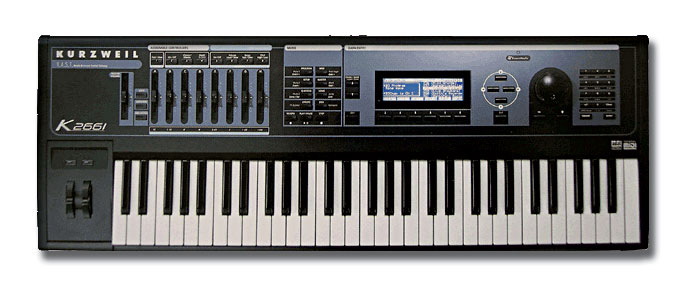K2661

|
Kurzweil K2661 is a DSP based, 127 algorithm, 48-voice polyphonic synthesizer/sampler workstation. It is the upgraded version of the famous K2000/2500 synthesizers with a completely redesigned circuit board and with the incredibly powerful Triple Modular Processing. Synthesis The synthesis, this instrument uses, is called V.A.S.T., which stands for Variable Architecture Synthesis Technology. It is a unique system of pre-defined algorithms with a number of variables, individually editable DSP functions and digital oscillators, combined with the internal or external PCM samples. There are 32 MB of onboard ROM (including the previously optional 4 MB Stereo Grand Piano, 8 MB Orchestral, 8 MB Contemporary and 8 MB General MIDI boards) + 2 optional sample ROM boards - 8 MB Stereo Dynamic Piano and 8 MB Vintage Electric Piano) + max of 128 MB sample RAM. With optional SMP-61 advanced sampling expansion boards, which add analog and digital sample inputs, K2661 works as a full sampler. Without SMP-61 installed, K2661 works as a fully functioning sample player. The external RAM sample can be fully edited using the following functions; Sample Start, Attack, End, Cut/Copy/Paste; loop forward, backward, bi-directional looping and loop bypass; truncate, fade in, fade out, reverse, cross-fade looping with selectable curves and many other. Some of the above mentioned functions can be used with internal ROM samples as well. Internal or external samples can be filtered (HPF, LPF, 12db/oct, 24db/oct, BPF, notch, peak, all pass, steep resonance), equalized (several EQ types), mixed with digital oscillators (digitally generated waveforms like sine, sine+, LF sine, saw, saw+, LF saw, square, square+, LF square), distorted and cross modulated. Other DSPs available are shaper, high freq. stimulator, digital wrap, noise generator, PWM, X-Fade, amplitude modulation, panner, etc. All individual parameters are fully editable (Hz, cent, dB, sec, msec settings, which offers significant advantages over the usual 1-127 convention). Each sound program can consists of up to 32 layers. KB-3 is now installed as a standard. It provides a powerful tone-wheel organ synth model, fully polyphonic over the keyboard. Each single voice contains nine harmonics that may be blended in real time using the sliders. There are 4 organ maps available with rotary speaker emulation, vibrato/chorus, percussion, key click, parametric EQ, etc. K2661 is a 16 channel multi-timbral synthesizer with a sophisticated "invisible" multi mode. Each preset or user program in Program Mode can simultaneously work on a different MIDI channel (1-16). This means that no complicated Multi or Performance mode is used for multi-timbral operations. There are two dedicated buttons on the panel to browse between individual channels/programs. However, for those who use the “Performances” and “Multis” the Setups are available as well. Setups There are several differences between programs and setups. Program can include several layers but plays only in one Zone on one MIDI channel. A setup enables user to utilise up to eight keyboard zones, each of which can have its own MIDI channel, program and control assignments. There can be up to 100 setups saved in each memory bank. The K2661 internal sequencer is one of the best hardware sequencer ever made. It includes 32 fully editable tracks, 16 song and 16 arrangement tracks, 768 ppqn resolution and sequencer functions which include: Linear, Pattern and Step Drum Machine Record Modes, Reference Quantize, Non-destructive Track Editing, Cut, Copy and Paste facilities. Sequences can be triggered in real time from the keyboard (Advanced Auto Arranger functions). Another feature, called RAM Tracks, enables the sequencer to record audio signal along with the MIDI tracks. The audio data is saved in sample RAM rather than to hard disk. MIDI data is stored in Program RAM, however, this means that it uses your expensive and limited P-RAM capacity. Unlike with the previous models, K2661 offers the KDFX effect board as a standard. KDFX is an advanced digital reverb and effect unit with digital I/O and superb sonic possibilities. It is based on Kurzweil´s VLSI chip. Available effects include 15 reverbs, 7 delays, 11 modulation algorithms (chorus/flange/phaser), 9 distortions, 5 tonewheel organ effects, 14 special effects (filters, shapers, etc.), 24 multi-effects, and 21 studio/mixdown effects (compressors, expanders, gates, and Eqs, tremolo, enhancers, autopanners, stereo image manipulators, and SRS simulated 3D). VLSI DSP chips can be upgraded with new software. There are 5, full bandwidth, stereo buses, 8 outputs and 8 inputs from ADAT digital I/O or analog sampling I/O and flexible routing scheme. With the optional sampling SMP-61 upgrade, the K2661 can also work as a vocoder. Vocoder reduces the polyphony in proportion to the number of used filter bands (up to 24, two notes are used per filter band). The vocoder may be combined with the Live mode. Microtonal tuning There are 17 pre-programmed intonation tables all of them are freely user editable. The polyphony is 48 voices (together with a maximum of 192 oscilators - 48 sample playback and 144 synthesizer waveforms). Special voice allocation system, first patented for K250, is used. This system analyses the most frequently used sounds in multi-timbral mode so the "voice stealing" effect is nowhere near as obvious as with other synthesizers. Each program can consist of up to 32 layers. A tired programmer can play the computer game called "Pong" on the K2661 display. The instruments has a unique and "fat" sound, and is excellent in multitimbral settings. It is not necessary to "sweeten" the sound with reverbs. The rich editing functions expanded by the awesome Triple Mode offer immense sound possibilities for analog emulations. The instrument offers superb acoustic sounds, excellent pads, as well as extreme non-harmonic digital colors. K2661 is useful for all music styles and is excellent for electronic and techno music. With the right soundware, K2661 can easily outperform all VA synthesizers. To evaluate the instrument's capability, please listen to our K:Works Modern Synth demo here, and K:Works Gold demo here. |

